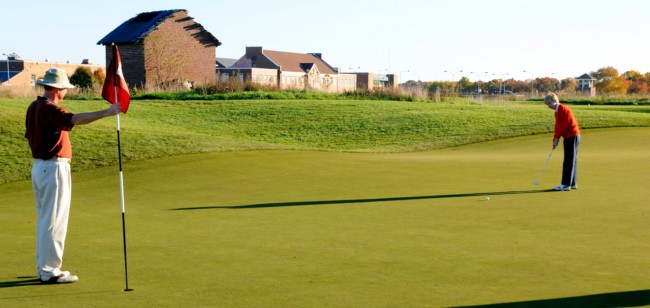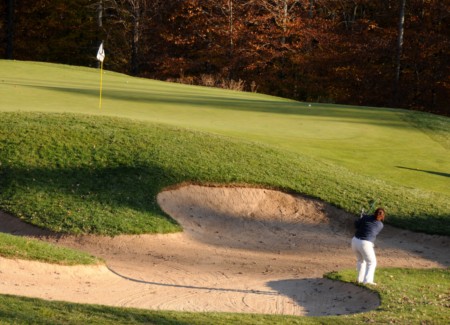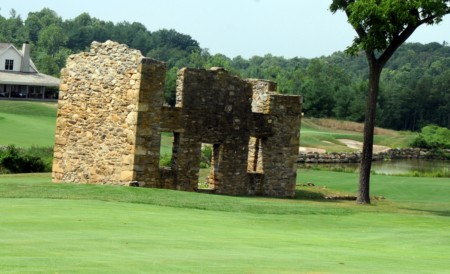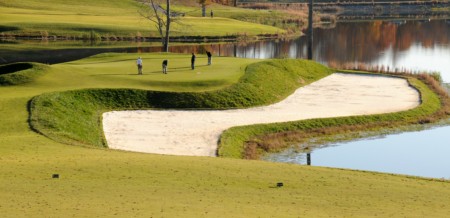There was a time when a golfer visiting Washington needed one thing above all: a friend who belonged to a country club. Playing public golf in the nation’s capital was like watching a congressional committee mark up a tax bill. The process was crowded, slow and not very attractive.
But while Congress has, against all odds, gotten worse recently, things have changed for the better on the Washington golf scene.
Indeed, for a golfer visiting Washington, this is a golden age. In the past decade or so, half a dozen or more first-rate daily fee golf courses have opened in the metropolitan area. They’ve encountered economic headwinds–a recession and a general stagnation in American golf rounds. But that’s all to the good for the visiting player. Tee times aren’t hard to come by, and the competition keeps prices affordable—usually under $100 and sometimes quite a bit lower than that.
So here’s my list of the Top Five public golf courses in the Washington area. Rating golf courses is like rating restaurants. One diner’s delectable sushi is another diner’s inedible raw fish. And one golfer’s favorite course might not appeal to another golfer. But I think most Washington area golfers would agree that the five courses on my list, while not necessarily all in their own personal top fives, are excellent tracks. They’re good designs, thoughtfully laid into interesting terrain. There’s great variety within each collection of 18 holes. They’re well kept, with plush fairways, immaculate greens and full-service practice facilities. Their staffs are, for the most part, efficient and welcoming. Several of them are graced by an interesting historical note—the guard towers from an old penitentiary, or stone ruins of an old farm house. They’re all about 20-25 miles from the center of Washington and they’re all well worth playing.
1. Laurel Hill, Lorton, Va. The venue for the 2013 U.S. Public Links championship was built on land that once belonged to the District of Columbia’s penitentiary. The prison closed in 2001, and incarceration’s loss became golf’s gain. Architect Bill Love laid out a big, challenging golf course that’s part of the Fairfax County park system. It makes wise use of some steep elevation changes, with holes running dramatically up or down hillsides. But it’s the greens that make Laurel Hill the area’s best. They’re slick and smooth and you’d better figure out the correct place to land your approach shot if you want to make par. The only complaint I’ve heard about Laurel Hill is that the indifferent staff seems to have been trained in a government bureaucracy. For my full review, click here.
1A. Westfields, Clifton, Va. The factors separating Westfields from the top spot are greens and topography. The course is built on an essentially flat piece of ground. The design team of Fred Couples and Gene Bates had to use bulldozers to create most of the contours. And the greens aren’t quite as slippery or confounding as Laurel Hill’s. But those are marginal differences. Westfields is a course that requires both power and finesse, and it’s well-conditioned. It’s also got a friendly, accommodating staff, a factor that just about balances the slight difference in the golf courses. So it’s No. 1A on my list. For my full review, click here.
3.
Whiskey Creek, Ijamsville, Md. Three good courses opened up a decade or so ago at the end of the I-270 corridor in suburban Maryland: Whiskey Creek, P.B. Dye and Worthington Manor. Whiskey Creek is the best of the three. It’s a Michael Poellot-Ernie Els design built on the slopes of a steep ridge that was once, legend has it, the site of an illicit distillery. The course confronts the player with some intriguing choices. There are alternate routes on the par-five 9th and 18th holes. The gambler who chooses the more hazardous path and hits it long and straight is rewarded with birdie opportunities. There are some good panoramas from the higher elevations, and the fifth hole could be used as a hang-gliding park. For my full review, click here.
4.
Lake Presidential, Upper Marlboro, Md. Landmark Land, the developer of Kiawah Island and other first-class properties, presents the best course in Prince George’s County, to the east of Washington. The eponymous lake is a 30-acre dammed stream, and the routing takes advantage of it with three memorable holes—Nos. 8, 9 and 18. But the proof of this course’s quality is a couple of short par fours, the 11th and 17th, that are sporty and fun. The course’s only flaw is the development that is growing around it. You’ll hear construction sounds as you play and you’ll get a look at lots of design ideas for houses and condos. For my full review, click here.
5. Blue Mash, Laytonsville, Md. The operators of this Arthur Hills design have a revolutionary concept: golf is supposed to be fun. To that end, they’ve created a year-round series of special events, from speed golf at dawn (the players run) to night golf, in costumes, at Hallowe’en (the balls glow in the dark). That’s not to say that there isn’t a lot of good old standard golf available at Blue Mash. There is. For my full review, click here.
I could have done a Top Ten, filling it with names like Worthington Manor and Augustine, without giving anyone a bum steer. And for those willing to go farther into exurbia, there are excellent choices like Cannon Ridge, near Fredericksburg, Va., and Maryland National, out past Frederick. The Washington area will never be Pinehurst. But it’s become a destination that justifies paying an airline fee for transporting your golf clubs.
If only fixing Congress were as easy.




